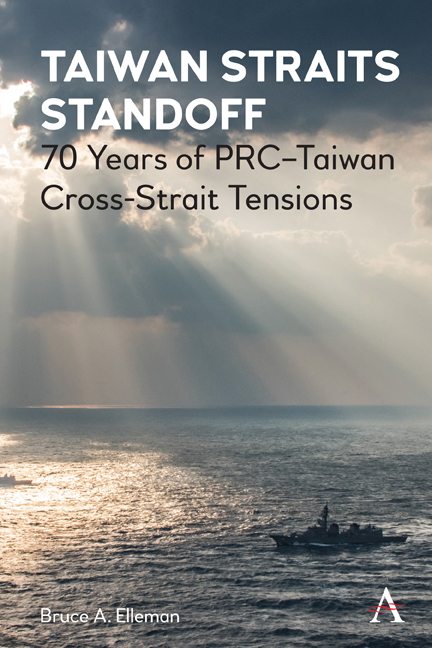Book contents
- Frontmatter
- Dedication
- Contents
- List of Illustrations
- Introduction: Stalemate along the Taiwan Straits, 1949–2020
- 1 The Two Chinas and the Battle for Control of Offshore Islands
- 2 President Harry S. Truman’s Decision to Protect Taiwan
- 3 The First Taiwan Strait Crisis, 1954–55
- 4 The Evacuation of the Dachen Islands, 1955
- 5 The Second Taiwan Strait Crisis, 1958
- 6 The US Threat to Use Atomic Weapons
- 7 Using Taiwan to Undermine the Sino-Soviet Alliance
- 8 Taiwan during the Cold War and Afterward
- Conclusions: The Taiwan Strait’s Strategic Significance Today
- Appendix: Naval Terms and Acronym List
- Selected Bibliography
- Index
8 - Taiwan during the Cold War and Afterward
- Frontmatter
- Dedication
- Contents
- List of Illustrations
- Introduction: Stalemate along the Taiwan Straits, 1949–2020
- 1 The Two Chinas and the Battle for Control of Offshore Islands
- 2 President Harry S. Truman’s Decision to Protect Taiwan
- 3 The First Taiwan Strait Crisis, 1954–55
- 4 The Evacuation of the Dachen Islands, 1955
- 5 The Second Taiwan Strait Crisis, 1958
- 6 The US Threat to Use Atomic Weapons
- 7 Using Taiwan to Undermine the Sino-Soviet Alliance
- 8 Taiwan during the Cold War and Afterward
- Conclusions: The Taiwan Strait’s Strategic Significance Today
- Appendix: Naval Terms and Acronym List
- Selected Bibliography
- Index
Summary
The Taiwan Strait was ignored through the 1960s, especially after the USSR and PRC went to war in 1969. In 1972, President Nixon visited Beijing, and in 1979 President Carter recognized the PRC. From 1979 through 1989 the United States and the PRC actively cooperated against the USSR, with Washington authorizing sales of high-tech naval equipment to China. This helped to limit tension in the Taiwan Strait. In fact, after 1979 the need for the Taiwan Patrol Force itself seemed to be long past. However, the US government maintained a strong interest in Taiwan's defense and continued to sell it weapons. With the end of the Cold War in 1989, followed soon afterward by the 1991 collapse of the USSR, the unsteady balance of power in the Taiwan Strait began to shift once again.
These events gave China an unforeseen opportunity to expand its influence in Asia. It rapidly began to build up its naval forces, in part to fill the military vacuum left by the Soviet Union's retreat. With the help of the new Russian Federation—mainly sales of advanced naval equipment, including Sovremennyy destroyers and Kilo submarines—the PLAN began a long period of growth. The PRC also developed a large missile force, deployed mainly against Taiwan. Arguably, it has been this rapid military growth that has in recent years upset the PRC–Taiwan military balance.
The growth of the PLAN has, in turn, created a strategic shift that has produced in a sense an unofficial reinstitution of the Taiwan Patrol Force. During 1995–96, as a result of PRC missile testing off Taiwan, the USN responded by sending aircraft carriers and destroyers into the region. This naval demonstration was similar to the USN's response to the Taiwan Strait crises of the 1950s and early 1960s. In fact, these events represented yet another Taiwan Strait crisis.
The 1995–96 Taiwan Strait crisis
After 37 years of relative peace in the Taiwan Strait, tensions broke out again in 1995. The July 1995 missile tests by the PRC are often portrayed as a response to the granting of an American visa to Taiwan's President Lee Teng-hui for an unofficial visit to Cornell University in early June. However, the real issue was the PRC's concern over Taiwan's rapid democratization and the growing separatist claims by large numbers of Taiwanese.
- Type
- Chapter
- Information
- Taiwan Straits Standoff70 Years of PRC–Taiwan Cross-Strait Tensions, pp. 135 - 144Publisher: Anthem PressFirst published in: 2021

